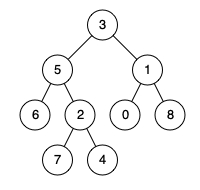LeetCode 236. Lowest Common Ancestor of a Binary Tree
Tree
Given a binary tree, find the lowest common ancestor (LCA) of two given nodes in the tree.
According to the definition of LCA on Wikipedia: “The lowest common ancestor is defined between two nodes p and q as the lowest node in T that has both p and q as descendants (where we allow a node to be a descendant of itself).”
Example 1:
Input: root = [3,5,1,6,2,0,8,null,null,7,4], p = 5, q = 1
Output: 3
Explanation: The LCA of nodes 5 and 1 is 3.Example 2:
Input: root = [3,5,1,6,2,0,8,null,null,7,4], p = 5, q = 4
Output: 5
Explanation: The LCA of nodes 5 and 4 is 5, since a node can be a descendant of itself according to the LCA definition.Example 3:
Input: root = [1,2], p = 1, q = 2
Output: 1Constraints:
The number of nodes in the tree is in the range
[2, 105].-10^9 <= Node.val <= 10^9All
Node.valare unique.p != qpandqwill exist in the tree.
Solution
PreviousLeetCode 158. Read N Characters Given Read4 II - Call multiple timesNextLeetCode 238. Product of Array Except Self
Last updated
Was this helpful?